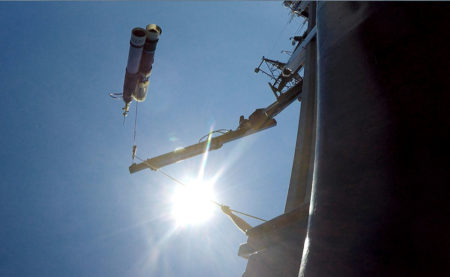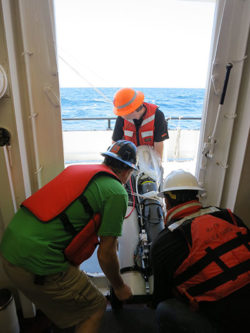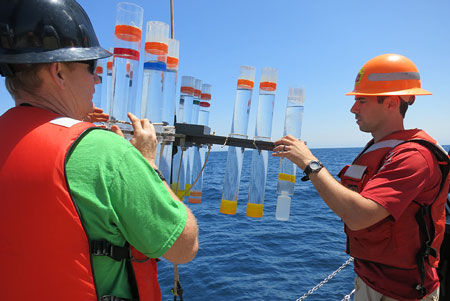
A Carbon Flux Explorer hangs from a boom seconds before it drops into the ocean. (Credit: Jessica Kendall-Bar)
At 2:27 p.m. today, the first Carbon Flux Explorer was deployed, and if all goes well, we will see it again in about 24 hours. Its entry into the water did not come with the cheers I had expected. I was told that this was because many of the researchers had done this before, and there was still a great deal of work to do after the launch. (I still clapped.)
While the float was on the boat, the researchers programmed in a 30-minute delay in activation so that it wouldn’t start sinking right after deployment. What followed after the Carbon Flux Explorer (CFE) was dropped into the water was a meditative half hour of watching the float bobbing along the water’s surface to make sure it sinks as scheduled.

Researchers carefully move the Carbon Flux Explorer robotic float out to the deck for deployment. (Credit: William Kumler)
It did, and it is spending the subsequent 24 hours at various pre-programmed depths ranging from 100 to 500 meters. It will surface periodically to let researchers know where it is and to send out the data it collected.
Two of the four Carbon Flux Explorers on this trip – numbers 1 and 3 – have been used before. Number 3 was the one sent out today. The other two Carbon Flux Explorers – numbers 2 and 4 – have the new sample collection system installed so that researchers can correlate the data analysis from the optical readers with what they find in the trays.
The researchers nicknamed the two newest robotic floats CFE Cal because they enable calibration of the data, and they conveniently show off a bit of school pride.
This is our second day at the Santa Cruz Basin, near the Channel Islands, where tests will continue for another two days. The number of experiments being run by the scientists keeps the research vessel active around the clock.
In addition to the data and samples collected by the Carbon Flux Explorers and CTDs, Mike Stukel, assistant professor at Florida State University, is helping characterize the biological carbon pump by conducting “plankton tows” with a net dragged beside the boat to capture zooplankton.

Marine technician Steve Lambert and FSU professor Mike Stukel prepare to launch sediment traps. (Credit: Sarah Yang)
“Zooplankton usually go deeper into the water column during the day to escape predators,” said Stukel. “They come back up at night to feed, so I expect there to be more samples from the 9 p.m. tows than the 9 a.m. ones.”
For more direct measurements of carbon, Stukel will be using sediment traps with cylinders to collect sinking particles.
“The sediment traps are a more traditional method of getting the same type of data that Jim is collecting,” said Stukel. His data will be used to help calibrate the information from the Carbon Flux Explorers.
Phoebe Lam at UC Santa Cruz appears to be getting the short end of the stick when it comes to experiment time, often getting the night shift on research vessels.
“The in-situ pumps I run take several hours to complete, which locks up the wires during a time when others can sleep,” said Lam. Lam’s tests are scheduled to start at 11 p.m., which means recovery won’t be complete until 3 or 4 a.m. On top of that, there will be three more hours of processing time once the samples come back.
The winches won’t get much of a break because the next CTD deployment is scheduled for 6:30 a.m. tomorrow. Since I was trained today to operate the tag lines for the CTD Rosette (fun with ropes!), I’ll be taking that morning shift for the instrument’s deployment.
Be sure to return to this site once the voyage ends (and more bandwidth is available) for more photos — and videos — from the research effort.
